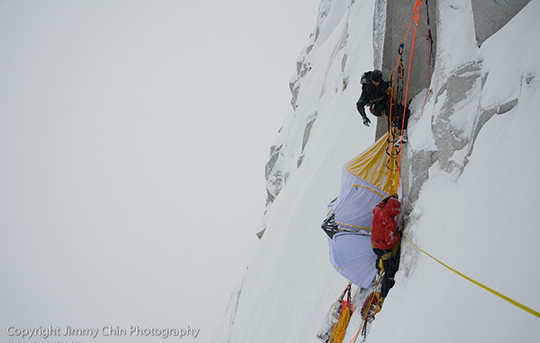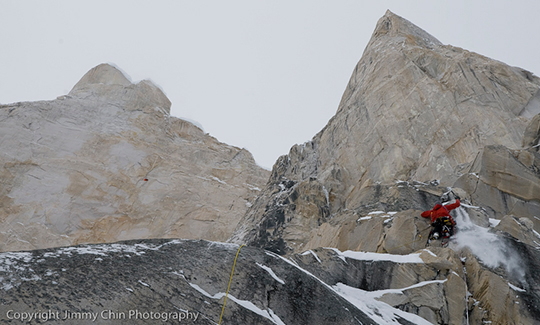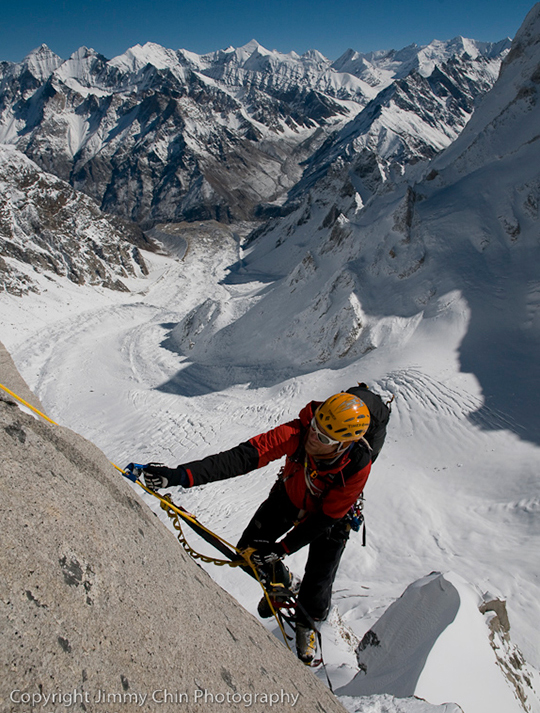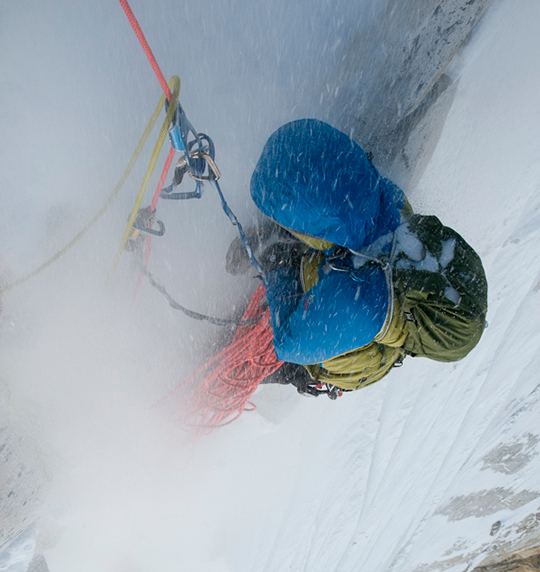There are certain mountains that have a primal resonance with humans. When someone sees the spire of Cerro Torre for the first time their eyes light up. It defies gravity. Meru, in the Garwhal Himal, is a similar mountain. The central peak is defined by a blade of granite, its curvature like a flame curving upward from the depths of earth.–Conrad Anker, July 21, 2015

[Photo] Jimmy Chin
FEW TRAVELERS EVER SET EYES ON THE CITY. Nor is there any one opinion about its true location: the island of Patmos, the forests of Guyana, the Gobi Desert or the north face of Mount Meru are among the suggestions. All these are desolate places. The names of the City are equally various: Uttarakuru, Avalon, The New Jerusalem, The Isles of the Blessed. Those who saw it reached their destination after terrible hardships. In the seventeenth century two Spanish murderers proved you don’t have to be Ezekiel to mistake a rock face for Paradise.–Bruce Chatwin, In Patagonia
IT BEGAN SIMPLY ENOUGH. In the autumn of 1985, in Utah’s Little Cottonwood Canyon, a broad-shouldered man with shaggy, dark hair and weatherworn hands stepped out of a white panel-van and struck up a conversation. Above the pullout, the light felt like fire from the sky down the smooth granite slabs. Between the rocks and the dry leaves, the shadows turned crisp and cold. I couldn’t believe Mugs Stump just said that he’d watched me solo a circuit of routes on Gate Buttress and that he thought I was doing well. At thirty-six, Mugs had a fearful list of legendary ascents: the Emperor Face on Mt. Robson, the East Face of The Mooses Tooth. His skin shone with the patina of wind and sun and cold mountain air. I was only twenty-two years old, a skinny, wide-eyed university student who aspired to dedicate his life to climbing, who longed to go to the big mountains and who didn’t know how.
Between adventures in the Greater Ranges, Mugs often drifted into the gear shop where I worked in Salt Lake City. As he bought the occasional brick of chalk, he would lower his voice, look me in the eye, and share a moment of an epic climb half a world away. The best stories were always about the summits he didn’t obtain. In 1983, at 7000 meters on the West Face of Gasherbrum IV, he and Michael Kennedy spent five nights stormbound on the tip of a sharp ice ridge, staring into a grey void. When the storm abated, they retreated, but Mugs treasured such memories. Nearly a thousand years ago, his favorite poet, Han Shan, had dwelled in a cave high on “Cold Mountain,” challenging the society of Ancient China: “Who can break from the snares of the world and sit with me among the white clouds?”

[Photo] Jimmy Chin
To me, Mugs was a seer. He used big, hard routes to try to cross into that ideal space where you climb without conscious thought and imagine an unlimited reality. I wanted to experience what he did. And then, that one day, he asked me to go climbing. That was it.
OVER THE NEXT FEW YEARS, Mugs became my mentor. He called me the “Grasshopper,” and he was the “Sensei.” During trips to the caked-on mud of the Fisher Towers, the bright granite of Yosemite and the shifting sandstone of Zion, he tried to toughen me with mental workouts: repeating pitches with less gear, soloing or simply driving long distances without talking. “We know I can lead this, let’s see if you can,” was his standard send-off before a runout. I had to do my best. I couldn’t let him down.
Although Mugs rarely shared much with the media, his exploits were part of the community’s collective lore. Little by little, I learned the secret, inner stories behind his climbs, the fragments of his thoughts and dreams. In 1989 we were stuck for eight days on a portaledge on the Eye Tooth in Alaska. All around us, the landscape faded into whorls of snow. “This is just like Gasherbrum IV,” he said. “We don’t need the summit. Just being here, in the present, that’s enough.”
Two other routes stood out: one he climbed and the other he fantasized about. On the Moonflower Buttress of Mt. Hunter, with Paul Aubrey, he led past a curtain of ice that seemed like a veil of fragile foam. “Never had concentration made such a deafening roar in my head,” he wrote in the 1982 American Alpine Journal and in Mountain 85, the only times he ever published an account of a climb. “I screamed in order to release the fullness.” They bivied 2,000 feet above waves of blue clouds, with nothing to consume except melted snow and lemon drops. “I felt part of some great movement, one of infinite scale, too grand to see but only to feel in the night’s wind…. I was a shell, the same as the figure beside me and the mountains around.” Mugs stopped at the top of the 4,000-foot buttress, and they rappelled the line. “I wanted to see the route again, from a different perspective.” By not continuing to the summit, he kindled a debate: What constitutes an alpine ascent? The end of the wall, or the ridge, or the summit?

[Photo] Jimmy Chin
The Shark’s Fin of Meru Central was Mugs’ dream climb. Hidden behind the crystalline spire of Shivling, this sheer blade of stone culminates at the 6310-meter middle summit of a peak in the Garhwal Himalaya of India. Here, as Professor Meera Baindur explains, “The body of God [intertwines] with the body of the landscape, bridging the sacred and the physical.” Shivling represents Lord Shiva, the Hindu deity of destruction. When the Ganges River fell from heaven, its waters became tangled in Shiva’s hair, trickling out of the source at Gomukh, fed by the glaciers below Meru.
In both Hindu and Buddhist traditions, a mythic mountain called “Meru” is the center of the universe. A series of concentric circles spreads out from its core in layers of worlds, stratified like the porches of an Indian temple. Its spire crosses the boundary between earth and heaven. For thousands of years, Hindu pilgrims have trekked up the moraine to the mouth of the holy river and the base of these peaks. So many ascetics (sadhus or babas) dwell here that the region is called Tapovan, which combines the Sanskrit words for “spiritual practices” and “forest.”

[Photo] Jimmy Chin
For an alpine climber, the physical shape of Meru Central possesses a raw power that even the uninitiated can appreciate. On its eastern side, the Shark’s Fin consists of an overhanging wall of granite guarded by an alpine ridge, which in turn, is protected by a steep ice slope. If you could find a passage up these lower sections, you would then face a final fortress of smooth and ice-streaked rock. The line would combine every technique of free, mixed and aid climbing with all the challenges of a cold environment. Like a great sculpture, its beauty needed no interpretation.
Mugs had tried the Shark’s Fin in 1986 and 1988 with various partners. He was turned back by an avalanche, a shoulder injury and heavy snow. When speaking of the peak, his voice dropped to a reverential whisper. On the back wall of his van, he tacked a tattered cover of Mountain with a photo of the Shark’s Fin framed perfectly against a blue sky. He covered the image with a weatherworn prayer flag, only sharing it with his closest friends.
The pull of the line reminded me of the duality in Mugs’ life. He was drawn by Buddhist teachings of non-attachment and their contrast with the competitive spirit of international alpinism. His favorite ascents were done without a trace and kept private. He dreamed of sitting in the dark corner of a bar, listening quietly to others brag about their “first ascents” of the routes he’d climbed. The publicity and controversy of the Moonflower seemed in opposition to this cherished ideal. Even after years of climbing together, Mugs remained mysterious to me. Most of the time, he was happy to share the energy of the rope. Yet he turned fiercely possessive about certain peaks. There was something about Meru he could never let go.
In May 1992, he guided the South Buttress of Denali in a storm. On the way down, the edge of a crevasse broke beneath his feet, and he fell into its depths. A client rappelled into the chasm to look for him. All that appeared were blocks of blue ice, covered in dense, hard snow.
I felt as though a light had gone out.
[This story is from Alpinist 38–Spring 2012. To read Alpinist’s review of the film Meru and to watch the theatrical trailer, click here. Stay tuned for Chapter 2.–-Ed]